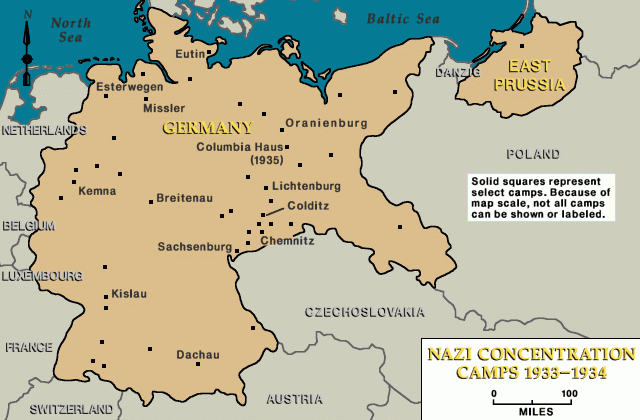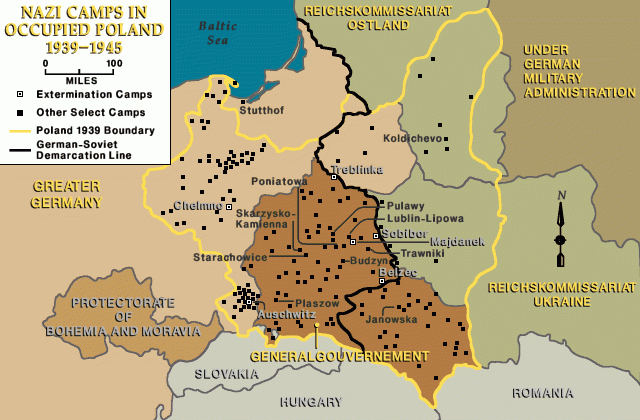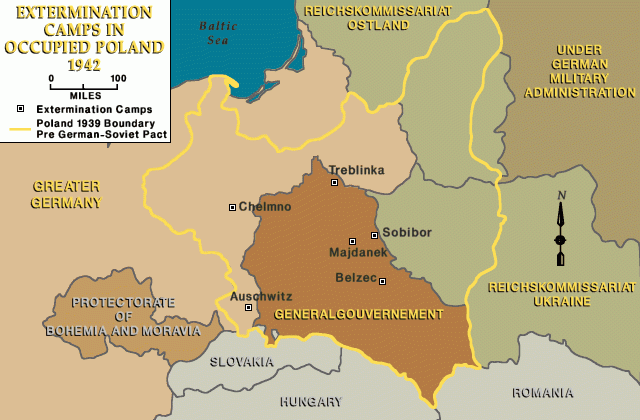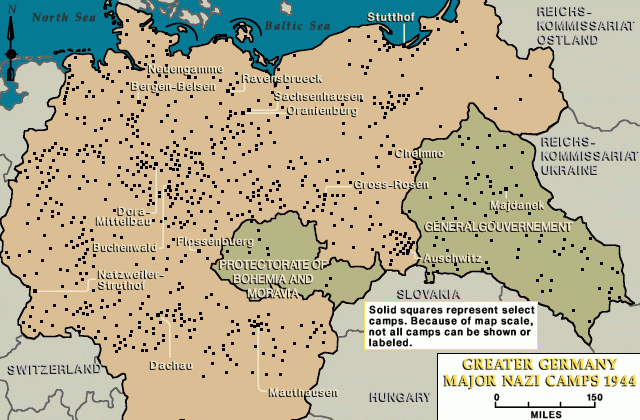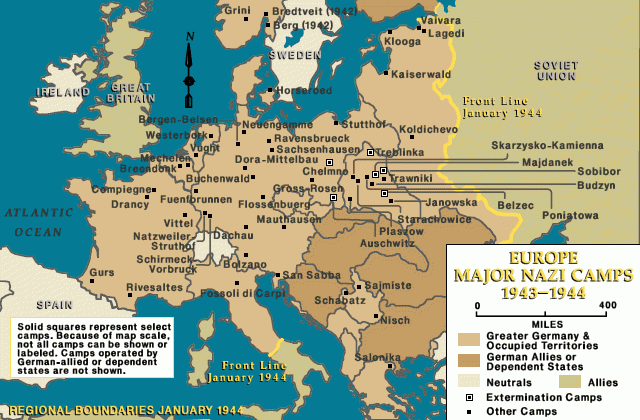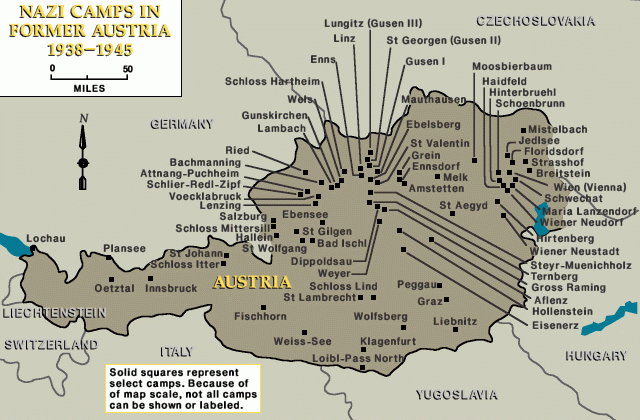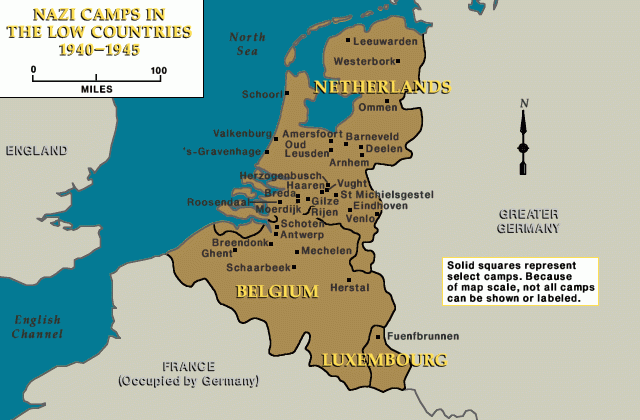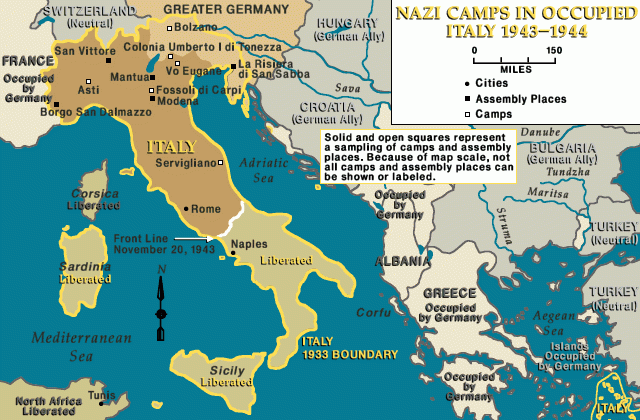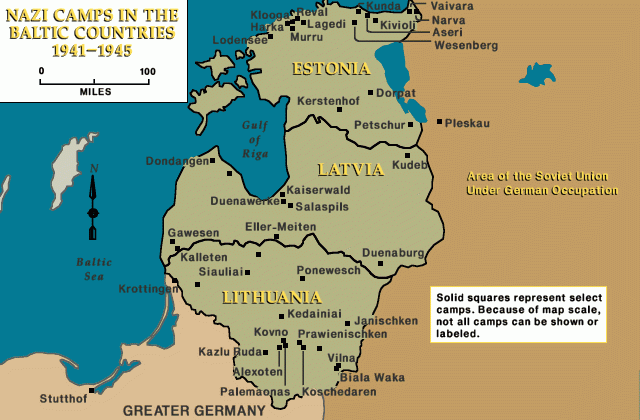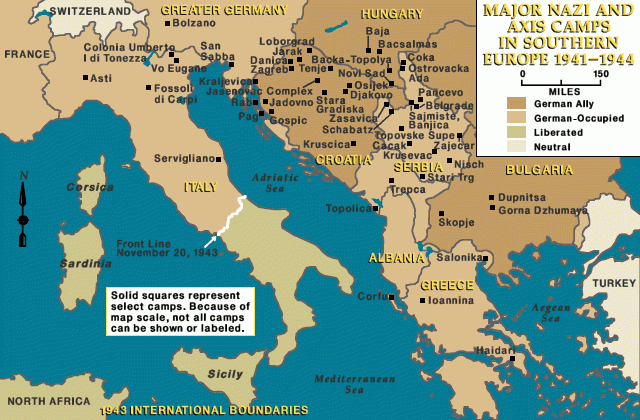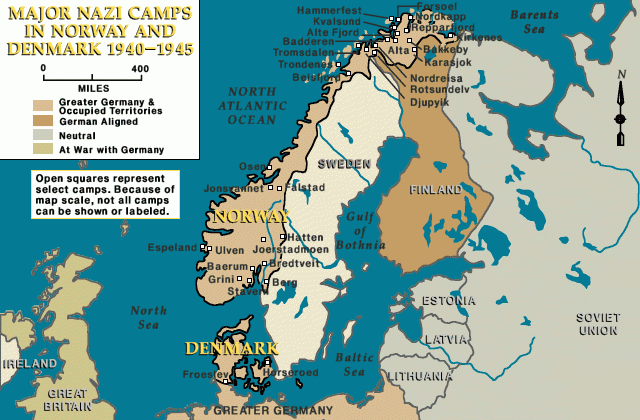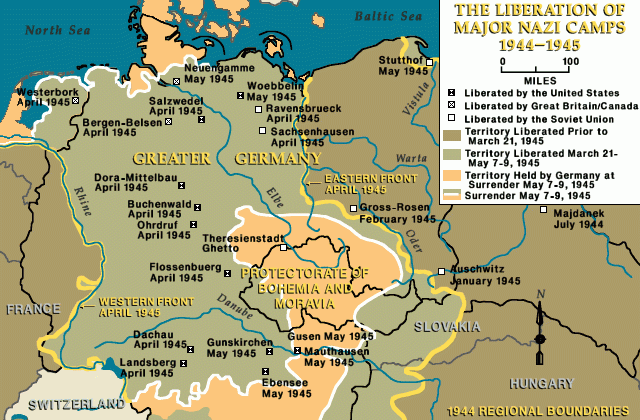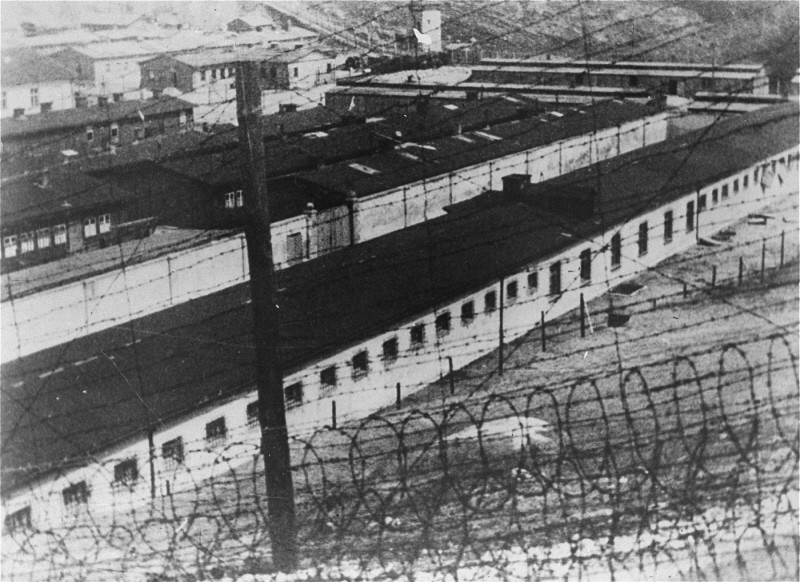
Nazi Camps
Between 1933 and 1945, Nazi Germany established tens of thousands of camps. The regime imprisoned millions of people in these camps. The Nazis used these detention sites for many purposes, including the imprisonment of real and perceived enemies and the mass murder of Jewish people. Nazi camps were sites of cruelty, torture, deprivation, unchecked disease, grueling forced labor, and extreme violence.
Key Facts
-
1
Millions of people were imprisoned in Nazi camps during World War II.
-
2
The Nazis used several types of camps in the process of carrying out the mass murder of Europe’s Jews.
-
3
People often refer to all Nazi camps as concentration camps, but concentration camps were just one type of Nazi camp.
Nazi Germany (1933–1945) imprisoned people on a massive scale in a vast network of camps and other detention sites. There were tens of thousands of Nazi camps that belonged to multiple different camp systems. Many different German administrative authorities operated these camps. The Nazis created these camps and camp systems at different times and for different purposes.
The Nazis established camps from almost the moment they came to power in 1933. During World War II (1939–1945), however, the scope and scale of camps took on new and extraordinary proportions. Notably, it was during the war that the Nazis established camps specifically to carry out the mass murder of Jews.
Nazi camps continued to be sites of torture, suffering, deprivation, and mass murder until the bitter end of the war. It was only the Allied powers’ defeat of Nazi Germany and the liberation of Nazi camps that brought this widespread terror to an end.
Since 1945, some Nazi camps have become memorial sites, museums, or archives. They are places where people can learn about the horrors of Nazi camps as well as the people who were imprisoned and murdered there. In recent decades, research projects, including the United States Holocaust Memorial Museum’s Encyclopedia of Camps and Ghettos, have uncovered, documented, and memorialized thousands of detention sites.
Types of Nazi Camps
Between 1933 and 1945, Nazi Germany imprisoned people in tens of thousands of sites throughout Germany and German-occupied Europe. Many of these sites were called “camps.”
The major types of Nazi camps included:
- early camps;
- concentration camps;
- Zigeunerlager (literally, “Gypsy camps”);
- forced labor camps;
- prisoner of war (POW) camps;
- transit camps and collection camps for Jews; and
- killing centers (also called “death camps” or “extermination camps”).
There were also many other types of Nazi detention sites, including ghettos; Gestapo prisons; youth detention camps; prisons and penitentiaries; and Germanization facilities. Furthermore, there were killing sites that did not function as camps. These included the “euthanasia” T4 killing centers, where the Nazis murdered people with disabilities.
Additionally, Nazi Germany’s allies and collaborators administered camps and other detention sites. These included camps and ghettos in the Transnistria Governorate where Romanian authorities imprisoned Jews; transit ghettos for Jews in Hungary run by Hungarian officials; internment camps such as Gurs and Les Milles run by French authorities; camps such as Jasenovac in the Independent State of Croatia; and internment camps in Slovakia.
Below is a chronological list of Nazi camp types. Each section introduces a type of Nazi camp; explains who administered the camp; and describes which prisoner groups were imprisoned in them.
Early Camps, 1933–1934
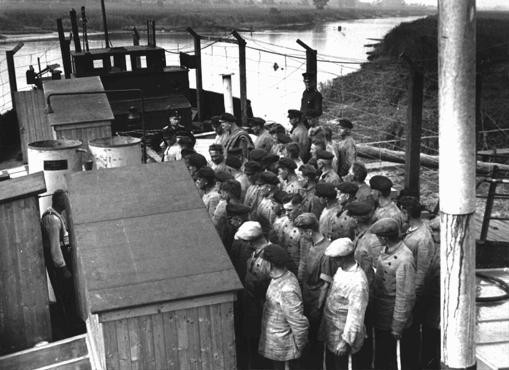
Detention camps in Nazi Germany were established soon after Adolf Hitler's appointment as chancellor in January 1933. They were created on an ad hoc, improvised basis as part of the Nazi regime’s wave of terror against the Nazi Party’s political opponents. In 1933, tens of thousands of prisoners were held in these early makeshift camps. The vast majority of prisoners in these early camps were young men who were members of the German Communist Party or its affiliates. Most were never charged with a crime.
There were at least 100 early camps located throughout Germany. These camps were not all the same. They differed by location, administration, and purpose. A variety of German officials at the state and local levels created these early camps. Many of the sites were run by Nazi paramilitaries. Examples of early camps included, among others:
Most of the early camps only existed for a short period of time. As the regime stabilized, these early sites were often closed, consolidated, or standardized as official SS concentration camps. Many of the prisoners were released from these early camps.
Concentration Camps
Nazi concentration camps (Konzentrationslager) were a specific type of Nazi camp administered by the SS (Schutzstaffel, Protection Squadron). Initially, the Nazi regime used concentration camps to terrorize and incarcerate political opponents. But over time, the Nazis also imprisoned other groups in the concentration camp system. The SS brutally exploited these prisoners for forced labor.
Administration and Structure of Concentration Camps
Beginning in 1934, the SS Inspectorate of Concentration Camps (Inspektion der Konzentrationslager, IKL) administered the concentration camp system. Later, concentration camps were under the SS Economic-Administration Main Office (SS-Wirtschafts-Verwaltungshauptamt, SS-WVHA). The Nazi concentration camp system transformed over time. Eventually, it was organized into main camps and satellite camps (often called subcamps).
Nazi concentration camps were sites of extralegal detention. Unlike prisons, concentration camps were independent of any judicial review. The Nazis imprisoned people in these camps without charging them with a crime. Prisoners were held there indefinitely and without legal recourse. There was no guarantee they would ever be released.
The SS created a standardized system for its concentration camps. Barbed wire fences and watchtowers surrounded these camps. They were guarded by SS units.
In all concentration camps, the SS dehumanized prisoners. In most cases, prisoners’ hair was shorn upon arrival. Prisoners were forced to wear prison uniforms. They were assigned prisoner numbers, which camp staff used instead of their names. The SS used badges to mark prisoners as belonging to different prisoner groups. They fed the prisoners a starvation-level diet and provided inadequate clothing and medical care. SS guards and prisoner functionaries beat, tortured, abused, and sexually assaulted prisoners with little or no repercussions.
Concentration Camp System
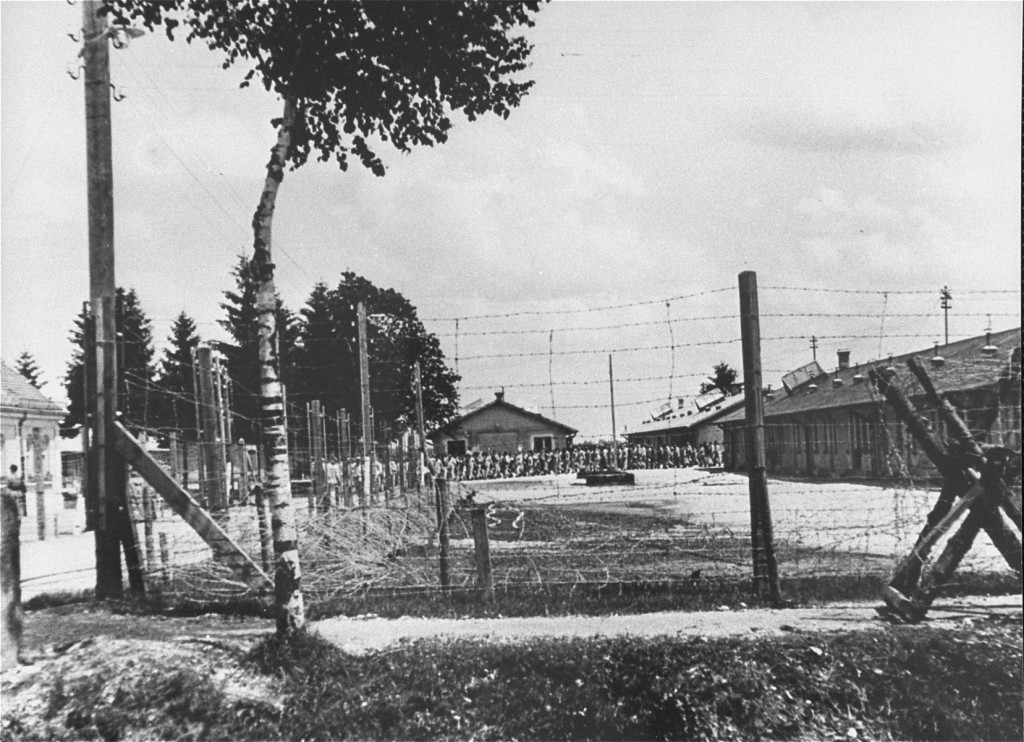
The first official SS concentration camp, Dachau, was established in March 1933. This camp became the model for the administration and organization of SS concentration camps.
In addition to Dachau, the Nazis established other concentration camps in Germany before World War II, including:
- Sachsenhausen;
- Buchenwald;
- Flossenbürg;
- Mauthausen (in annexed Austria); and
- Ravensbrück.
During World War II, the Nazis continued to expand the concentration camp system. New concentration camps included, among others:
- Neuengamme;
- Gross-Rosen; and
- Bergen-Belsen.
The Nazis also created three major concentration camps during the war in German-occupied Poland. These were:
- Stutthof;
- Lublin/Majdanek; and
- Auschwitz (which eventually included the Auschwitz-Birkenau killing center).
There were also concentration camps in other parts of German-occupied Europe, including Herzogenbusch (Vught) in the Netherlands and Natzweiler in France.
In total, more than two million people were imprisoned in Nazi concentration camps. Hundreds of thousands of these prisoners died in them.
Zigeunerlager (“Gypsy Camps”)
Beginning in 1935, German authorities began to establish Zigeunerlager (literally, “Gypsy camps”) where they interned Roma and Sinti in Germany and some annexed territories. These camps were local initiatives, usually involving local German police forces, governments, or city councils. They were located on the outskirts of many towns and cities. In the camps, Romani people were subject to curfews, surveillance, and poor conditions. Many (but not all) Roma and Sinti in Germany were forced to move into such camps.
Among the most notable Zigeunerlager in Nazi Germany were:
- Berlin-Marzahn;
- Lackenbach; and
- Köln-Bickendorf.
During World War II, the Nazis deported many Romani people from these camps to German-occupied eastern Europe, where many were murdered. Some were deported to the Auschwitz-Birkenau concentration camp. There, they were imprisoned in a subsection of the camp that was often referred to as the “Zigeunerlager” but formally designated as Section BIIe. Romani people were imprisoned in Auschwitz after being deported from central and western Europe.
Forced Labor Camps
During World War II, the Nazis subjected millions of people to forced labor under brutal conditions in many different types of camps. In these camps, the Nazi regime and private companies exploited the labor of prisoners for economic gain and to meet labor shortages.
The major types of forced labor camps included:
- camps for foreign forced laborers (civilians from other countries, especially Poland and the Soviet Union, deported to Germany to perform manual labor for the German war effort);
- labor education camps (Arbeitserziehungslager, or AEL), such as Syrets, run by the Gestapo and used to imprison workers and forced laborers accused of committing sabotage, fleeing, or otherwise being unwilling or reluctant to work; and
- labor camps for Jews in eastern Germany (Upper Silesia, today in Poland), German-occupied Poland, and eastern Europe, including Blechhammer, Janowska, Plaszow, Skarżysko-Kamienna, Pionki, Starachowice, and Częstochowa.
Concentration camps and forced labor camps shared some similarities. Both were places where the Nazi regime and private companies exploited prisoners for forced labor. But there were also important differences. Concentration camps were standardized and under the administration of the IKL and WVHA. Forced labor camps, however, fell under various administrative authorities; they were not standardized. Typically, prisoners in forced labor camps did not wear prison uniforms or have prisoner numbers. The distinction between these camp types became increasingly blurred near the end of the war as some forced labor camps became subcamps of concentration camps. This was the case, for instance, with Blechhammer, which became a subcamp of Auschwitz in 1944.
Prisoner of War Camps
During World War II, the German military (the Wehrmacht) created hundreds of prisoner of war camps to house captured enemy soldiers. The organization and administration of these camps was complex and varied by branch of service. The commandant, camp staff, and guards came from the Wehrmacht. Most were military personnel, but some were civilian employees of the military.
Some POW camps were located within Germany. Others were established in German-occupied areas. In some cases, Germany treated captured POWs in accordance with international law. This was usually the case for POWs from western Europe, Great Britain, and the United States. In contrast, the German military treated POWs from the Soviet Union as racial and ideological enemies. They subjected them to grueling conditions and mass murder.
The largest and most important type of POW camp was called a Stalag (Stammlager). The Stalags housed tens of thousands of soldiers for long periods of time. There were also other types of camps in the POW camp system. Additionally, the German military administered internment camps for civilian internees from enemy countries. These were called Internierungslager or Ilags.
POW camps were often moved from place to place. So, unlike other types of Nazi camps that were often named by their location, POW camps were generally assigned a number. One example of a POW camp is Stalag IX B.
Transit Camps and Collection Camps for Jews
During World War II, Nazi German authorities created transit camps (Durchgangslager) and collection camps (Sammellager) to temporarily imprison Jewish people.
Transit and collection camps played an important role in the “Final Solution to the Jewish Question,” which was the Nazis’ plan to systematically murder Europe’s Jews. As part of the "Final Solution," the Nazis forced Jewish people from their homes and then transported them (usually by train) to ghettos, killing sites, and killing centers. For Jews from western and central Europe, these types of camps served an intermediary role. They were sites where Jewish people were imprisoned after being forced out of their homes, but before being deported. These camps were often the last place of detention for Jews in their home city or country. Tens of thousands of Jewish people passed through these sites as part of the "Final Solution."
Typically, Jews were imprisoned in transit camps and collection camps for several days. Major transit camps included:
- Westerbork in the Netherlands;
- Drancy in France; and
- Mechelen/Malines (also known as the Kazerne Dossin) in Belgium.
The Theresienstadt ghetto also functioned as a transit camp for Czech Jews.
Major collection camps included the camps at Kleine Sperlgasse, Castellezgasse, and Malzgasse in Vienna as well as Große Hamburger Straße in Berlin.
Killing Centers (also called “Death Camps” and “Extermination Camps”)
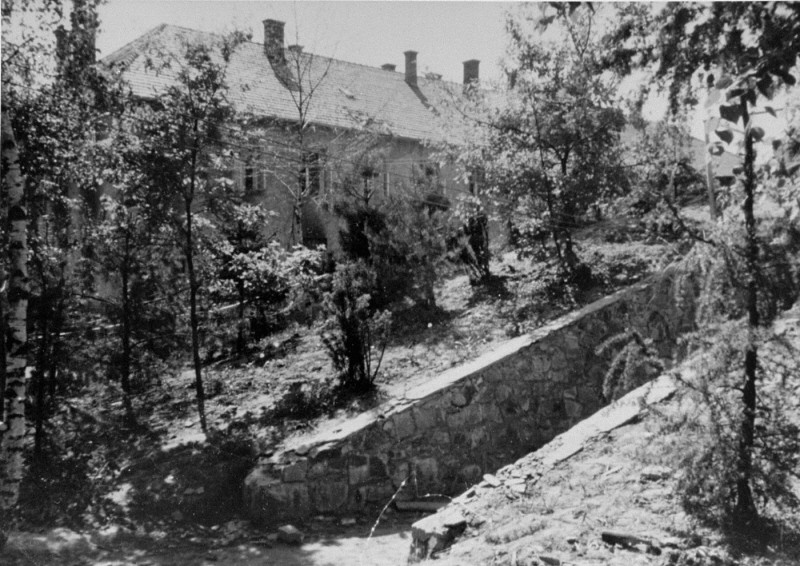
As part of the "Final Solution," the Nazi German regime created five killing centers, specifically to murder Jews. In English, killing centers are sometimes referred to as “extermination camps” or “death camps.” The primary means of murder at the killing centers was poisonous gas released into sealed gas chambers. The five killing centers were:
- Chełmno;
- Belzec;
- Sobibor;
- Treblinka; and
- Auschwitz-Birkenau.
The Nazis built these killing centers in 1941–1942 for the sole purpose of murdering Jews on a mass scale.
Approximately 2.7 million Jews were murdered in the five killing centers. This is slightly less than half of all Jews murdered in the Holocaust. In total, the Nazis, their allies, and their collaborators murdered six million Jewish people in the Holocaust.
Critical Thinking Questions
How did the functions of the camp system expand once World War II started?
How could the development of a system of concentration camps be a precursor to mass atrocity and genocide?


